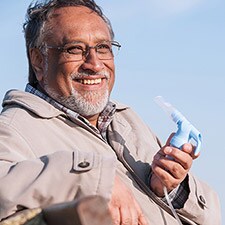Living with COPD
Ask anybody around you what COPD is, the chances are that they will not know. However, as per a recent report by Global Burden of Disease Report, Chronic Obstructive Pulmonary Disease or COPD as it is common known; kills more than 600,000 people in India each year. In fact, it is among the leading causes of death after cardiovascular diseases. COPD is a progressive lung disease that can lead to serious consequences for the sufferer. It presents itself in a number of different ways. Usually, the symptoms may not appear evidently until later stages, and you may end up delaying its diagnosis. However, you can always look for COPD symptoms such as difficulty in breathing, frequent wheezing, coughing, tightness in the chest and excess mucus. Currently, there is no cure for the disease and the damage caused by it is irreversible. But, the good thing is that we understand COPD well enough to manage it considerably, slow its progression and lead a longer life. If you have been recently diagnosed with COPD, you will be expected to make incremental and small changes to your lifestyle that will bring major improvements in your everyday life. To combat the disease, you need to be aware of factors that may contribute to COPD or worsen its symptoms. In many patients, genes could also be a major contributing factor in the development of the disease. Activities such as smoking and exposure to high pollutants including pollution, chemicals, dust, etc., should be avoided. In short, anything that could irritate the lung should be kept away, and on-going care must be administered. When you are suffering from COPD – depending on the severity of your condition – you may experience fatigue frequently. Even a small amount of work might seem like a daunting task. Simple tasks like getting a shower or changing clothes might leave you gasping for breath. Lung infections could play havoc with your energy levels, activity, and movement. In COPD patients, the muscles responsible for enabling passage of air will have to work much harder than a normal person requiring higher energy level. This puts the focus on nutrition. COPD patients need to watch what they eat and ensure ample supply of calories so that they meet their body’s increased demand for energy level. Doctors usually take two medication approaches to treating COPD condition. One approach involves the widening of airways so more air can pass through, and the other is containment of the inflammation due to airway swelling. The treatment is usually administered through antibiotic medicines, especially in the case of treating lung infections. For continued treatment, oxygen therapy is commonly prescribed for COPD patients. In extreme cases, surgery may be needed including a lung transplant when its functioning is severely impaired. There are multiples ways to deal with COPD effectively depending on the type and severity of the condition. You can even substantially improve your overall quality of life and lead a long life. However, the most important aspect of dealing with COPD is the right access to information on disease management, nutrition, and exercise guidelines. Although living with COPD could be challenging, but it is not the end of the world. In fact, it is the beginning of a journey towards a higher quality life. All you need to get there is access to the right set of information, meet the right set of people who could help you, stay physically fit, manage breathing better, get a proper treatment plan, and stay positive.
Published on September 1, 2016
Reference:
Related articles

Benefits of Oxygen Therapy
If you are suffering from Chronic Obstructive Pulmonary Disease (COPD) and it has reached an advanced (severe) stage, then it is likely that your doctor would prescribe you oxygen therapy. It is one of the most common treatments for COPD when the oxygen level in your blood drops to dangerously low.

Impact of smoking and air pollution on COPD
There is no denying the fact that the world we live in today is marred with air pollution. Whether it is outdoor or indoor, we are battling air pollution at all levels. According to WHO, tobacco consumption in the form of smoking is the biggest contributor of COPD in humans, whether it active or passive smoking.
8 Signs of Good Sleep
Most of us are aware of the golden triangle of good health – diet, exercise and sleep. While diet and exercise are something you do while wide awake and in full consciousness, sleeping is something you do when you, well, sleep! You can track your calories and count your push-ups, but good sleep is much harder to measure!
About US
Our Services
Find Us
Contact US
Call us
Whatsapp us
Email us





